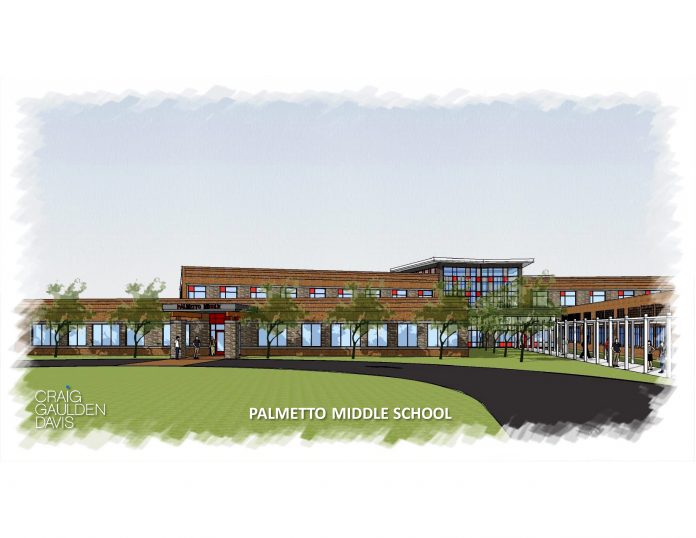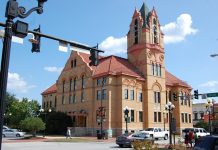By Stan Welch
A surprisingly, disappointingly small number of people attended a presentation by Anderson School District One superintendent Dr. Robbie Binnecker to explain the need for a $109 million bond issue to address the district’s serious infrastructure problems.
Approximately forty people were on hand; almost a dozen of them were district employees or consultants employed to study the needs facing the district. Still, Binnicker gave an enthusiastic and spirited pitch. He had plenty of information to work with. He began by reiterating the district’s reputation for superior academic achievements despite consistently low funding.
The average revenue spent per student has long been a staple of the district’s defensive position. That figure, which was $10,671 in the 2017-2018 school year was almost twenty five per cent lower than the state average of $13,214 per student. In addition, the district spends less on administrative costs than any district in the state except one; they are fourth in the state in terms of the percentage of funds spent on student instruction.
Having buttressed his argument for the district’s tradition of frugality, Binnicker quickly got to the meat of the matter. He began by pitching the need for greater attention to and funding of safety and security in the schools. Hampered somewhat by the need to remain vague on the security measures currently in place throughout the district, he nonetheless made it clear that much of the hardware dedicated to security, such as cameras, is obsolete. “We have added hardware, and the newer equipment is fine. But the equipment that is seven or eight years old is no longer adequate. Those of you who have home computers know how quickly they become out of date. We at the district know that as well.” He also stressed that software shortfalls are significant, citing the need for real time access to surveillance footage.
He also explained that several schools have no physical structures in the entryway portion of the building that would allow a shooter or other assailant to be physically, structurally isolated before they could make contact with students or personnel. “Several schools need the addition of secure vestibules. These schools give visitors access to hallways and school wings without ever having to pass a formal entrance station, such as the reception office or a checkpoint. This has to be addressed. This circumstance is a glaring failure in our security plans.”
Every school in the district would require actual, physical alterations, such as updating and replacing cameras, improving access control at various access points, and the creation of the aforementioned secure vestibules. None of the expenses discussed involved the placement of a school resource officer in every school. Those costs have already been budgeted for. The estimates for expenditures in this area funded by the bond issue, if approved, would be approximately $5.7 million.
He made it clear that security is certainly not the only area where the infrastructure needs are serious and immediate. “ Palmetto Middle School (where the meeting was held) and Wren Middle School. Wren is sixty three years old, and Palmetto Middle is four years older than that. Our studies and calculations indicate that there is nothing to be gained by renovating such old properties. The costs would be comparable to new construction, and in the end, we would still have sixty year old facilities.” The estimated cost of constructing the two new schools would be eighty nine million dollars.
At the same time, he made it clear that virtually every school in the district, except for the relatively new Powdersville schools, will also require significant repair and improvement.
Eight schools would need extensive roof repair. An additional six facilities would require improved HVAC systems, at an estimated cost of eleven million dollars. Repairs and renovations to Palmetto High, Wren High and the adult education center at the old Pelzer Elementary building are estimated at five million dollars, and would help achieve compliance with the American Disabilities Act, among other improvements. Binnicker stressed that the district really needs to achieve an additional twenty years use from the two high schools.
Another issue driving the bond issue is the overcrowding through the district. A number of schools are currently using portable classrooms to manage the overflow of the students. Binnicker, armed with some impressive figures reflecting the explosive growth in the district, made it clear that such growth shows no signs of slowing.
“ In 2002, District One had 7600 students. Today, we have 10,250 students, an increase of thirty per cent in fifteen years. We anticipate an additional three thousand students in the next fifteen years. In the Powdersville area of the county, there are currently five thousand lots pre-approved for construction. The majority of the people who build on those lots will have children who attend our schools. The challenges we face right now are not going away.”
The proposed funding scheme for the projected improvements includes the use of twenty million dollars over the next five years; to be generated by local option sales tax funds, as well as three million which has already been budgeted and set aside from the district’s general fund. That leaves $109 million to be produced by the sale of bonds issued by the district.
On April 30, voters will go to the polls and will either approve or deny the issue of the bonds. If approved, the sale of the bonds, which will be repaid by property taxes, will have the following impacts. For every hundred thousand dollars of value for a homeowners primary residence an additional sixty four dollars a year will be imposed. Under Act 388, currently, no property taxes are paid for school operations.
Every ten thousand dollars of value for a vehicle will generate $9.60 a year in taxes, and a business will incur taxes of ninety six dollars a year per one hundred thousand dollars in value.
Binnicker said that if the referendum is defeated, only the most critical improvements will be made, based on the twenty three million dollars in revenues available from other sources.
District officials have held numerous meetings over the last two months.
A surprisingly, disappointingly small number of people attended a presentation by Anderson School District One superintendent Dr. Robbie Binnecker to explain the need for a $109 million bond issue to address the district’s serious infrastructure problems.
Approximately forty people were on hand; almost a dozen of them were district employees or consultants employed to study the needs facing the district. Still, Binnicker gave an enthusiastic and spirited pitch. He had plenty of information to work with. He began by reiterating the district’s reputation for superior academic achievements despite consistently low funding.
The average revenue spent per student has long been a staple of the district’s defensive position. That figure, which was $10,671 in the 2017-2018 school year was almost twenty five per cent lower than the state average of $13,214 per student. In addition, the district spends less on administrative costs than any district in the state except one; they are fourth in the state in terms of the percentage of funds spent on student instruction.
Having buttressed his argument for the district’s tradition of frugality, Binnicker quickly got to the meat of the matter. He began by pitching the need for greater attention to and funding of safety and security in the schools. Hampered somewhat by the need to remain vague on the security measures currently in place throughout the district, he nonetheless made it clear that much of the hardware dedicated to security, such as cameras, is obsolete. “We have added hardware, and the newer equipment is fine. But the equipment that is seven or eight years old is no longer adequate. Those of you who have home computers know how quickly they become out of date. We at the district know that as well.” He also stressed that software shortfalls are significant, citing the need for real time access to surveillance footage.
He also explained that several schools have no physical structures in the entryway portion of the building that would allow a shooter or other assailant to be physically, structurally isolated before they could make contact with students or personnel. “Several schools need the addition of secure vestibules. These schools give visitors access to hallways and school wings without ever having to pass a formal entrance station, such as the reception office or a checkpoint. This has to be addressed. This circumstance is a glaring failure in our security plans.”
Every school in the district would require actual, physical alterations, such as updating and replacing cameras, improving access control at various access points, and the creation of the aforementioned secure vestibules. None of the expenses discussed involved the placement of a school resource officer in every school. Those costs have already been budgeted for. The estimates for expenditures in this area funded by the bond issue, if approved, would be approximately $5.7 million.
He made it clear that security is certainly not the only area where the infrastructure needs are serious and immediate. “ Palmetto Middle School (where the meeting was held) and Wren Middle School. Wren is sixty three years old, and Palmetto Middle is four years older than that. Our studies and calculations indicate that there is nothing to be gained by renovating such old properties. The costs would be comparable to new construction, and in the end, we would still have sixty year old facilities.” The estimated cost of constructing the two new schools would be eighty nine million dollars.
At the same time, he made it clear that virtually every school in the district, except for the relatively new Powdersville schools, will also require significant repair and improvement.
Eight schools would need extensive roof repair. An additional six facilities would require improved HVAC systems, at an estimated cost of eleven million dollars. Repairs and renovations to Palmetto High, Wren High and the adult education center at the old Pelzer Elementary building are estimated at five million dollars, and would help achieve compliance with the American Disabilities Act, among other improvements. Binnicker stressed that the district really needs to achieve an additional twenty years use from the two high schools.
Another issue driving the bond issue is the overcrowding through the district. A number of schools are currently using portable classrooms to manage the overflow of the students. Binnicker, armed with some impressive figures reflecting the explosive growth in the district, made it clear that such growth shows no signs of slowing.
“ In 2002, District One had 7600 students. Today, we have 10,250 students, an increase of thirty per cent in fifteen years. We anticipate an additional three thousand students in the next fifteen years. In the Powdersville area of the county, there are currently five thousand lots pre-approved for construction. The majority of the people who build on those lots will have children who attend our schools. The challenges we face right now are not going away.”
The proposed funding scheme for the projected improvements includes the use of twenty million dollars over the next five years; to be generated by local option sales tax funds, as well as three million which has already been budgeted and set aside from the district’s general fund. That leaves $109 million to be produced by the sale of bonds issued by the district.
On April 30, voters will go to the polls and will either approve or deny the issue of the bonds. If approved, the sale of the bonds, which will be repaid by property taxes, will have the following impacts. For every hundred thousand dollars of value for a homeowners primary residence an additional sixty four dollars a year will be imposed. Under Act 388, currently, no property taxes are paid for school operations.
Every ten thousand dollars of value for a vehicle will generate $9.60 a year in taxes, and a business will incur taxes of ninety six dollars a year per one hundred thousand dollars in value.
Binnicker said that if the referendum is defeated, only the most critical improvements will be made, based on the twenty three million dollars in revenues available from other sources.
District officials have held numerous meetings over the last two months.
Binnicker said a recent meeting at Cedar Grove Elementary had approximately 250 people attend. Two additional community meetings are scheduled prior to the referendum vote. The next will be held
Thursday, March14 from 6 p.m. to 7:30 p.m. at Powdersville Middle School and another April 9 from 6 p.m. to 7:30 p.m. at Wren High. The public is invited to attend.
Thursday, March14 from 6 p.m. to 7:30 p.m. at Powdersville Middle School and another April 9 from 6 p.m. to 7:30 p.m. at Wren High. The public is invited to attend.

















